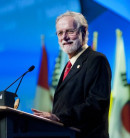
RadiumSpark is helping raise awareness & funding to research and find cure for Myalgic Encephalomyelitis/Chronic Fatigue Syndrome (ME/CFS) We are dedicated in bringing together our network to support this cause.
To make a donation to the Research Center at Stanford, please visit:
http://med.stanford.edu/sgtc/donation.html
Vision of the Chronic Fatigue Syndrome Research Center at Stanford (CFSRC) is to discover causes, a molecular diagnosis, and a cure for ME/CFS.
About ME/CFS:
“ME/CFS is a complex, multifaceted disorder characterized by extreme fatigue and a host of other symptoms that can worsen after physical or mental activity, but do not improve with rest. The onset of ME/CFS symptoms may be sudden—for example, immediately following a viral illness such as the flu—or gradual, with no discernible attachment to a specific event or time. These people are left extremely ill, often bedridden, and most will remain ill for the rest of their lives. There is no treatment or cure for ME/CFS. Roughly 17 million people worldwide (1 million to 4 million in the United States) have ME/CFS. It strikes people of all ages and racial, ethnic and socioeconomic groups. It is diagnosed two to four times more often in women than men.”
“It’s a syndrome that gets little respect in the medical community because, with no tangible cause and an ever-changing constellation of symptoms, patients often get labeled as hypochondriacs, malingerers or seekers of addictive pain medications. The primary diagnostic criterion for this condition is infuriatingly vague — “six or more consecutive months of severe fatigue” — virtually unchanged since 1994.”
A year ago, a sophomore at Stanford was studying computer science and was in extremely good shape. Things were going great. He had a 4.0 GPA and summer job offers from Facebook and Drop box. He had run varsity track in high school and once set a school record by doing 29 pull-ups. His medical history was a clean slate. He was infected with a ME/CFS. He became very ill and is now too weak to walk more than 100 feet or work for more than a few minutes in a day. He will most likely never recover, he will never be able to complete his degree, hold a job, or get married and have kids. Only 15% of patients will recover.
There is hope. Researchers have made significant progress in the last year towards better understanding this disease. A dream team of researchers at Stanford has assembled to tackle this virus. These researchers have access to state of the art equipment and can measure the levels of thousands of genes expressed in the body, track thousands of proteins, and pick up even the tiniest amounts of viral DNA. Most promisingly, they have identified 2 experimental drugs, one that fights viruses and another, which modifies the immune system, which works in about 2/3rds of ME/CFS patients. Everything is in place for to tackle this disease in the next several years except one thing: Funding.
“The hard truth is that most medical research labs rely in large part on U.S. government funding, and the ME/CFS research budget is insufficient to support a typical university research lab.”
“The National Institutes of Health, the largest funder of medical research in the United States, allocated only $5 million for ME/CFS research in 2013. (To put this in context, the annual NIH research budget for multiple sclerosis, with 400,000 sufferers, is $112 million.) The reasons behind this underfunding are complicated.”
“One factor is that the NIH funding process favors well-defined diseases that fit neatly into medical specialties like cardiology, cancer and neurology. Most of these medical societies have organized lobbying efforts, sometimes backed by pharmaceutical or medical technology companies. Another factor is that collectively ME/CFS patients are too sick to organize, raise money and lobby for research dollars. And then there is the stigma associated with the condition; some NIH grant reviewers are reluctant to fund research because they believe that ME/CFS is a psychosomatic disorder.”
The economic burden of ME/CFS, including annual health care costs, is estimated to be between $1.9 billion and $7.2 billion. Stanford’s goal is to raise $100 million dollars in private funding for ME/CFS research. This will allow understanding the details of the disease, and running larger clinical trials to prove these experimental drugs are effective. This level of funding will allow curing many cases of ME/CFS in the next several years, getting a million Americans back to work. With an economic impact of $26 billion, this is a better return on investment than received by the early investors in Facebook.
Sincerely,
RadiumSpark Inc.
For more information:
http://www.cdc.gov/cfs/general/
https://prevention.nih.gov/programs-events/pathways-to-prevention/workshops/me-cfs
Bibliography:
http://stanmed.stanford.edu/2014fall/immune-system-disruption.html
Read more: bmwslot88
